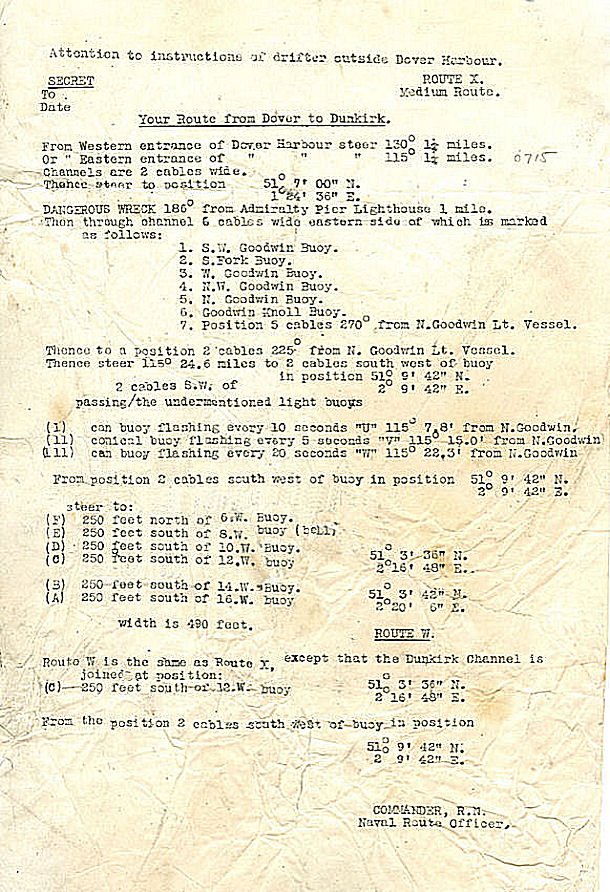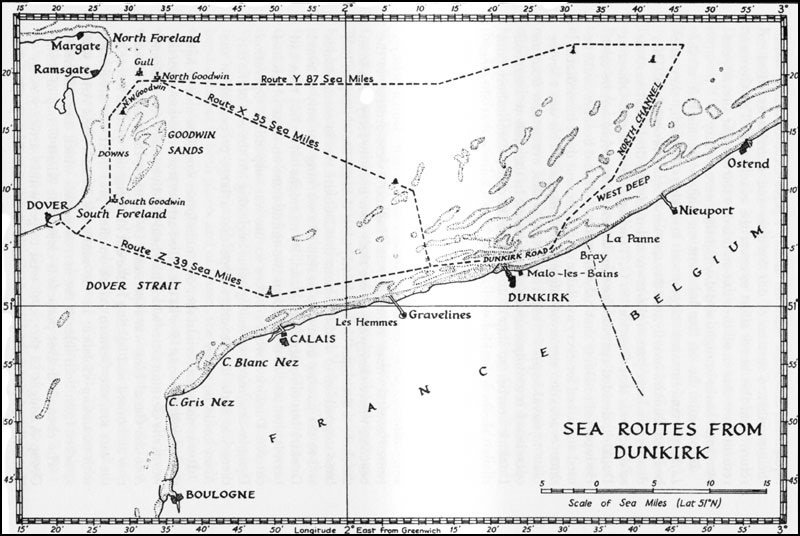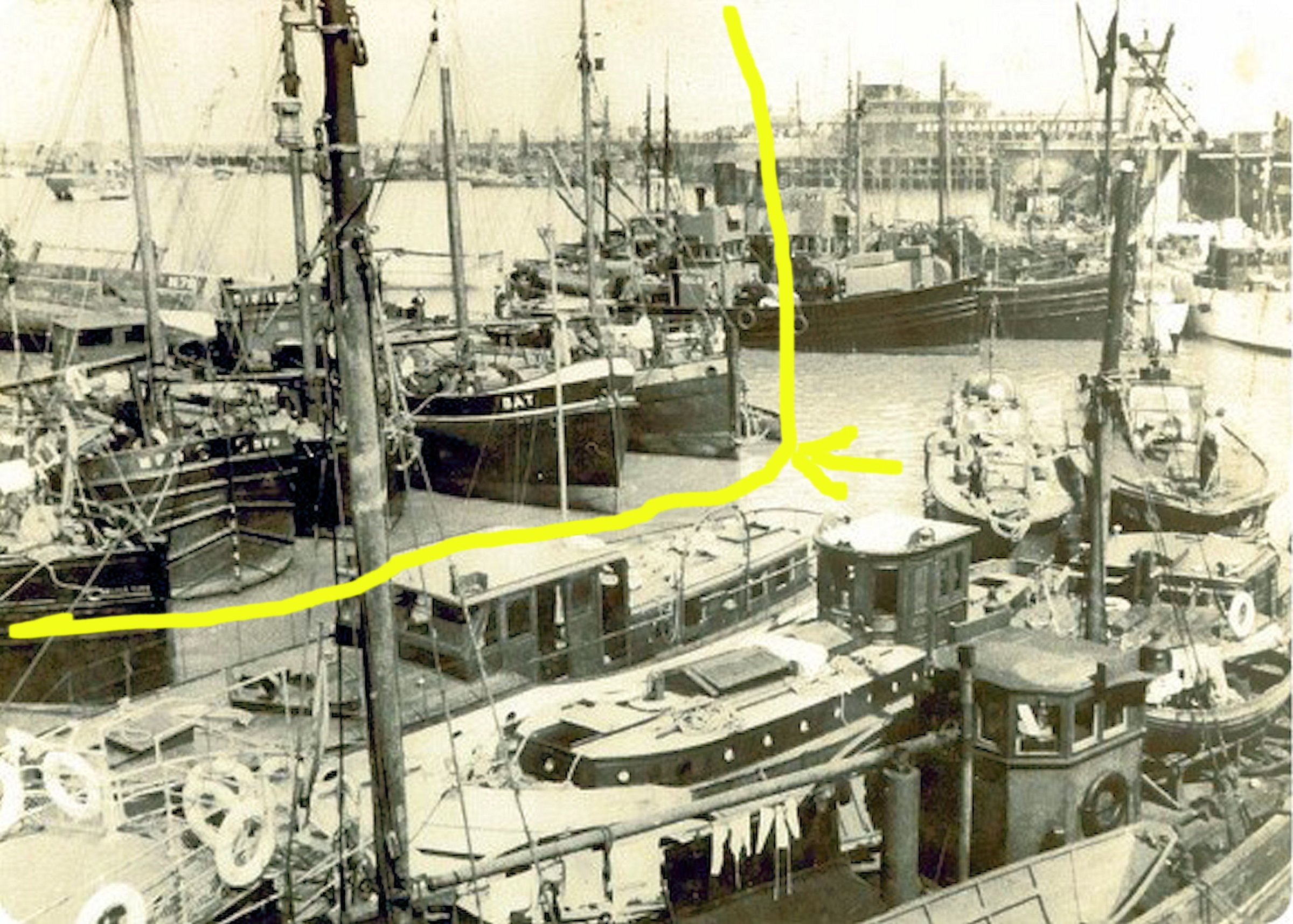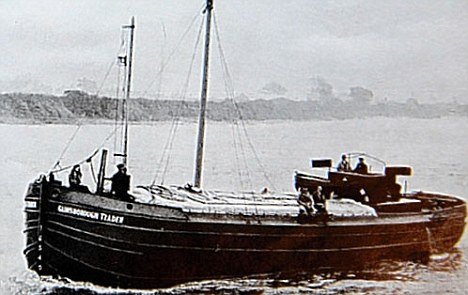

L.J. WILSON
Member-
Posts
8 -
Joined
-
Last visited
Content Type
Profiles
Forums
Events
Gallery
Blogs
Store
Everything posted by L.J. WILSON
-

Narrowboat rescues soldiers at Dunkirk
L.J. WILSON replied to King Learie's topic in History & Heritage
Thanks to this thread producing a contact, I now have another 3 Sprits'l Barges from Leigh-on-Sea, requisitioned for Operation Dynamo. Owned by Wm Theobalds, T/as Leigh Building [Supply] Co. Ltd. None of them reached the beaches - two were never sent out from Ramsgate; and two were towed across, damaged en-route, and returned, towed back to Ramsgate by the steam Tug SUN III [ Tugmaster's Log.] That means 36 civilian "little ships were requisitioned from the Southend-on-Sea Foreshore, not 33 as I thought I had fully identified in my paper. Southend-on-Sea's watermen contributed more little ships to the Dunkirk Evacuation's "inshore flotilla" than any other Home Port in Britain. -

Narrowboat rescues soldiers at Dunkirk
L.J. WILSON replied to King Learie's topic in History & Heritage
"Gainsborough Trader" aka MFH which was the acronym for "Master of Foxhounds", BTW. Motor cargo vessel of 48 tons, originally built of steel as a Humber Keel [or Wherry]. Boat Length: 21.64M Boat Beam: 4.96M Boat Draft: 1.5M Boat Displacement: 48.16 tons Boat Engine as of 2017: Kelvin 4 cyl Diesel Boat Construction: Steel; Boat Builder: Richard Dunston Ltd Built in 1931 as a flour barge and originally named the Gainsborough Trader, she was the first steel Humber Keel to have a motor as well as her sails and still retains her original Kelvin diesel engine, known as 'Harriet'. (Previously these vessels were either sailing barges or steam powered). MFH moved from the Humber to the Thames when Pickfords bought her as a lighter for their Port of London operation. From there she was transferred to their Isle-of-Wight "small cargo"-carrying Trade. MFH was requisitioned from Pickfords by the Southampton Area Naval Officer of the Small Vessels Pool, along with the other 5 vessels of that little Solent area fleet of motor lighters. Captained by her civilian Skipper WH. Smith, with her usual crew, - she arrived via Ramsgate in Dunkirk during a bombing raid on 31st May 1940. At Ramsgate, she would have loaded more fuel, and Victuals, andbeen issued instructions for Courses to steer that would have taken her through the minefields. See the attached copy of the sailing instructions issued, and a Map of the 3 Routes used by the Evacuation Fleet. At first MFH ferried troops from the beaches to the larger, much-deeper-draught vessels a mile-and-more offshore. Then she was ordered to the Mole to pick up 140 men and take them all the way back to England. According to Russell Plummer's notes she reached Ramsgate around 1000hrs Daylight Saving Time [aka DST], on June 1st, and landed 140 men. John S. de Winser's exhaustive Listings - taken from the contemporary Notes compiled by the Harbour Control Officers of the NOiC Ramgate, Capt. Phillimore - give the same arrival day and time, but only Lists 87 men as landed at Ramsgate. However - with Thames Sailing Barges of similar Tonnage noted as having packed-aboard over 200 men into the hold-spaces and on deck, it is almost certain that MFH was lifting 150--or more - exhausted soldiers from the beaches every ferrying trip she made - and in a night's duration she could have made five or six trips between the beaches and the larger vessels a mile offshore. "Little ships" departures from Ramsgate were timed to let them arrive off-the-beaches at dusk, work through the night hours and be away from the beaches by "false-dawn" - which was around 0450hrs DST on June 1st, 1940., to have the best chances of avoiding Air attack. So calculate she arrived off the beaches around 2130hrs DST on May 31st. The totals of the soldiers ferried out to larger ships were seldom noted by any Skipper in the heat of the Operation - only the numbers landed at English Ports. So I'd guess that overnight May 31st - MFH may have ferried over 800 men off the beaches, in addition to the 140 she is alleged to have lifted from the Harbour Mole. She was probably ordered back to England because of lack of fuel "on-location"; plus her civilian crew must have been absolutely exhausted. -

Narrowboat rescues soldiers at Dunkirk
L.J. WILSON replied to King Learie's topic in History & Heritage
Sorry -thanks for the head's-up -I thought I'd done the upload. Here's the 12page Intro - To Rescue Our Soldiers_ Dunkirk_Evac_Paoer_v.#4.8.pdf -

Narrowboat rescues soldiers at Dunkirk
L.J. WILSON replied to King Learie's topic in History & Heritage
There's an intro section of 12 pages on <academia.edu> under the Title - "To Rescue our Soldiers". The full paper is 180 closely typed A4-sized pages, and if you want to have access to download the full Paper - the product of over 50 years researches into our Family History gaining snippets of info here and there; and two years daily work writing it all up into a Paper which is nearly book-length with copious illustrations and explanatory notes, the price for a download link to Dropbox for the full pdf is £15.99. You send me a cheque -and when it has cleared, I'll send you the Dropbox URL. -

Narrowboat rescues soldiers at Dunkirk
L.J. WILSON replied to King Learie's topic in History & Heritage
Thames Sailing Barges at Dunkirk. 33 were requisitioned, and 16 actually made it across the Channel, with the ill thought-out ideas of A] loading them with stores and deliberately beaching them [that was when there was still the hope that Dunkirk could be held as a bridgehead] and Barbara Jean and Ethel Everard were two of those. And/or B] sinking enough of them to form improvised piers for shallower draft- vessels to come along collect troops and ferry out to the larger vessels in deep water. THAT idea was seen to be unworkable when some NO with practical experience of small boats* worked-out how many would be needed to form a useful pier of any length on the very shallow beaches [* - Small boat training had been de-emphasized in the inter-wars Royal Navy as harbour facilities improved worldwide, and warships no longer had to conduct lots of beach landings and boarding operations-at-sea of suspected Smugglers, so inter-War junior and middle-ranking Naval Officers (aka NO's) as a group - had little experience of small boat work. Those who'd done that during 1914-18 had risen up the Ranks of the Service or taken retirement; and the younger one's hadn't had the chances.]Three of the barges that were ordered to be deliberately beached, full of stores, - were actually refloated by the rising tides and - crewed by desperate soldiers - made their way back into English Waters, where they were sighted by patrolling ships, and towed into English Ports. And the iron Wherry - "Gainsborough Trader"? On May 27th, 1940 she was one of a little fleet of six motorized barges or 'motor lighters' maintaining a daily 'small goods'-carrying service between Portsmouth, The Isle of Wight, and Southampton. Five of these little vessels - all under 60 tons displacement - were owned by Pickfords, - the sixth by Vectis Shipping. All of their civilian crews volunteered for the "special Duty under Vice-Admiral, Dover"*, after they'd signed the Official Secrets Act and had the "work" explained to them. [* The new National Government didn't announce the BEF's evacuation to the French until May 31st] The Pickford's motor lighters were Bat, Bee, Chamois, Hound, and MFH* [*-Gainsborough Trader which had been re-named by Pickfords when they bought her for the Isle-of-Wight small-goods-carriage Service, - the picture of her is before the change of ownership]. There is a contemporary photo of the Pickford's vessels altogether on a trot at Ramsgate during the Dynamo Operation, see below. They came, they did their ferrying work, and they went back to the Solent area and just carried on with their normal daily duties after June 3rd, 1940. One of them -I forget which one -had run her diesel engine for 92 hours without a stop, during the Operation. And one of the crews had a stowaway - the 12year-old nephew of an engineer who normally acted as boatboy when not at school; and who wasn't going to be left out of the "big lark" - so he stowed away, with a bottle of Pop and a bag of sandwiches - until the little fleet was well on it's way up the coast towards Ramsgate and he knew the Skipper wouldn't turn back to put-him-ashore. And THAT makes him the youngest volunteer to take part in the Dunkirk evacuation! -

Narrowboat rescues soldiers at Dunkirk
L.J. WILSON replied to King Learie's topic in History & Heritage
Gallipoli ? My Dad was there too - as a 14yr-old civilian marine engineering apprentice [he'd been accepted at the age of 12yrs] , aboard one of the supply-carrying steamers. He was strictly forbidden to try going ashore, though he was in nominal charge of six 30ft launches built by his Apprentice-Master's Southend-on-Sea "Viking Marine Engineering Works, Prop. Mr. Geo Davis", - under an Admiralty Contract. Mr Davies' Contract said the boats had to be delivered to an Admiralty Representative at Tilbury Docks, accompanied by an engineer to teach the Navy crews how to run the Viking-Engineering's new-design "oil-engines". If that didn't happen, the Viking Works wouldn't get paid. Dad - a waterfront kid who had grown up around small boats; and had been closely involved in the building and fitting out of the 6 launches, - was the only "spare-hand" Mr Davies had available to send to take the launches up to Tilbury. The voyage up-river to deliver the boats was only a few hours trip, not dangerous, easily done in one Flood Tide; and surely the Navy would waive the Contractual "teacher Requirement", if given written instructions onstead? Dad had delivered the 6 little M/L's - one towing the other five upriver from Southend-on-Sea; and they were loaded as deck cargo aboard a Steamer due to sail for Gallipoli on the next tide. But the Navy Receiving Officer wouldn't sign-off the Contract unless that "teacher" was provided. According to my father, telegrams went to-and-fro; and a couple of the new "telephone calls" were made, the Navy agreed to accept Dad as the "teacher"on the voyage out, and in the Gallipoli Anchorage; my Grandmother gave her permission for Dad to go - 'so long as it wasn't dangerous'; the Steamer's Skipper agreed to the arrangement - he had to - Dad still being a Minor; the Navy Receiving Officer signed-off on the Contract - and the steamer sailed. And that's how Dad finished-up offshore in the Gallopoli Anchorage at the age of 14 yrs, teaching 6 boats' crews much older than him how to operate and maintain the Viking Works' new "oil-engines". He never mentioned how long he was out there - I assume only until the Steamer had discharged all the rest of her military stores, - and he came safely home, now with a blue-water sea voyage to talk about; and joined the Navy as soon as they would accept him in 1917. He signed-up for a career hitch; served until 1922 when the Geddes 'Axe' started the post-War Navy rundown and he was told that he'd have to wait 11 years for a Commission, coming up from the Lower Deck as he would have been, though he had gotten Wartime accelerated promotion to PO, MEM by the time he used the Geddes Scheme's offer to leave the Navy early, and taken the Bounty for doing so. -

Narrowboat rescues soldiers at Dunkirk
L.J. WILSON replied to King Learie's topic in History & Heritage
"The ADLS DIANTHUS never reached the Dunkirk beaches during Operation Dynamo". Another item I have noticed on this thread - upon which I can comment knowledgeably because of the research done from family and national Archives for my Dunkirk paper "To Rescue Our Soldiers" - is the mention of the ADLS M/L "Dianthus" - with a "For Sale" Listing elsewhere on this thread. Because the numbers of surviving "little ships of Dunkirk" were growing ever fewer, the Association was founded, - to encourage their Preservation. There are a number of sources of contemporary information on which the Authors of the 9 best books about the marine side of the Evacuation have drawn for info. One of them is Douglas Tough's List of the Thames M/L's he roused from their wartime "lay-ups" at Teddington, and sent off to the Small Vessels Pool collection point at Sheerness Dockyard under tow of several SUN Towage Tuga, the first one being SUB IX, skippered by the Founder of the Company [still in his pyjamas] - on the first day, May 27th, 1940, and on several days following. At Sheerness Dockyard, boats arriving were inspected by the RN's Fleet Engineer, Capt. T.E. Docksey and a small engineering team. Once the engines had been checked over, repaired if needed, and were running [remember, many of these craft had been laid-up afloat or ashore since 3rd Sept, 1939], and the water & fuel tanks had been filled, and charts provided from HMS Wildfire's Stores, 16 miles up the Medway river at Chatham; - craft were made-up into small tows of maybe 6-8 boats, and handed over to the Skipper of an exiled Dutch Schyut or "Skoot" or a Docklands Tug, to tow round to Ramsgate, where "naval crews will be provided!" Now, the ADLS seems to have taken the view that any vessel commandeered by the SVP Officers was to be classed as a "Dunkirk Little Ship". In fact, a number of requisitioned craft never made it across the Channel; as I said in my other post, some were sent back from Sheerness as "unsuitable for the Duty required". Because of inept crewing by "Drafty" - the HMS Pembroke Personnel Drafting Office at Chatham Naval Base which was "scraping the bottom of the personnel barrel", in the emergency, temporary Navy crews of barely-trained "Hostilities Only" Ratings were being assigned at an hour's notice to these small craft, -crews who had neither technical knowledge to run the numerous different types of engines the civilian M/L's had installed; and given into the charge of any Rating Drafty could find - the majority of whom had zero knowledge about working small craft on a lee shore on a falling tide. Remember, the RN hadn't conducted a major amphibious Operation since Gallipoli in 1915. In the 1939 Navy, "small craft training" was a Specialty, and most Naval vessels only had enough Small Craft Ops.-trained Ratings and P.O.'s for their own ships boats. At the time of the Dynamo Emergency, the Chatham Drafting Office had almost no Ratings available for these extra crews - each commandeered civilian M/L needing a skipper, a motorman, and a 3rd Hand. Vice Admiral Ramsey had initially called-for a mere 50 small motor launches - that meant the Drafting Office had to find 50 skippers, 50 motormen, and 50 Third Hands within 24 hours. So - back to DIANTHUS. She arrived at Ramsgate under tow on May 30th, and between that day and June 3rd, her RN crew made three attempts to get her across to Dunkirk, and failed every time; they couldn't keep her engines running, and they had some crew injuries. So the M/L DIANTHUS is a "Little Ship" requisitioned for Operation Dynamo that never got to the beaches; and because her untrained Navy crew reported "engine troubles" on every attempt [see Ministry Of Shipping File T.M. 9213/40 - "Reports of Masters and Crews of their experiences during Operation Dynamo" - in the National Archives at Kew] - DIANTHUS A] never went across the Channel, and B] because her engines were said to be 'unreliable' [they were in fact the very reliable Morris Navigator Petrol-Paraffin units which her temporary RN crew knew nothing about] - the M/L was not retained by the RN for further War Service, and by Jun 9th, she was on her way back upriver to be laid-up again at Tough's Boatyard at Teddington. DIANTHUS is clearly identified from astern in a Tow of 8-10 such little ships photographed just after the Tiug and Tow had passed under one of London's bridges, heading back up-river towards Teddington Lock.. -

Narrowboat rescues soldiers at Dunkirk
L.J. WILSON replied to King Learie's topic in History & Heritage
I cam across this topic via an online search for the details of the Thames Sailing Barge [aka TSB] "Pride of SHEPPEY", that finished her days as a floating clubhouse for the West Sussex County Council's Youth Sailing project of the 1960's -the "Barge Sailing Club", mud berthed alongside the seawall at Cobnor on the west bank of the Bosham-Itchenor Channel. [I was the Deputy Club Youth-Leader] When the WSCC bought her she'd been cut-down [her sailing rig taken out of her, to a motor barge; had then proved uneconomic because of her small 33Tons displacement, and had been hulked. The WSCC Youth Officer Ted Amos found her, the funds were granted by the Council, and the hulk was bought and towed round to her permanent berth, with 2 pumps running all the time to stop her sinking en route. Following those threads Dunkirk and Pride of SHEPPY - and David's comments - I have several Observations. 1] The definitive List of the 1,300 little ships of Dunkirk by Russell Plummer - "The Ships that Saved and Army" lists all 16 of the of the TSB's commandeered by the RUN. neither "Pride of SHEPPEY nor - SHEPPY" is listed. 2] Adm File 208/3 [The Red List for 15-9-1940 -Red Lists were regularly published during the 1939-45 War] - ["Minor War Vessels in Home Waters as of 4pm, 15th Sept, 1940"] will be the first Listing of all the small craft commandeered by the Navy on 27th/28th May for possible use at Dunkirk in the Inshore Flotilla, and RETAINED for War Service after the end of Dynamo on June 4th. I KNOW there is a sub-listing for the Thames Patrol at Holehaven, - as one of my father's small fleet of pre-war beach excursion boats was based at Holehaven as a river minesweeper - I looked her up in that List - - so I KNOW there is a Listing for that small Naval Detachment]. 3] Monarch? There is only one "Monarch" Listed in Plummer's exhaustive Books - and here are her details QUOTE - "Monarch" - beach-trip-boat converted to motor yacht by Haywood's Boatyard at Southend-on-Sea, 1936;41'6" x13'6" At time of requisitioning owners were T & G Baker. UNQUOTE. However, there was a tourist-tripper motor launch based at Littlehampton pre-War -also Registered with the Board of Trade for passenger carrying tourist excursions between Littlehampton and Arundel, - and other research suggests there may have been a "name" confusion between the 41'6" open motorboat mentioned which originally did river trips at Maldon in Essex; - and the 60' tripper open motor boat which did the same thing in Sussex. the Jury is still out on that one. And 4] The rumoured narrowboat putatively named something like Belvedeer? - i HAVE A POSSIBLE EXPLANATION. On May 14th 1940, an Admiralty message was broadcast by the BBC requesting all owners of self-propelled pleasure craft between 30' - 100' l.o.a. craft to send particulars the the Admiralty within 14 days, if they have not already registered [from the date of the BBc Broadcast on the 9-o-clock BBC news bulletin of May 14th, 1940. The original intention was to use the vessels for harbour Service duties, river patrols, estuary and Reiverine minesweepers, and to supplement land bound traffic as river ferries, because of the fuel rationing [coal, - and oil products] already in place. On May 14th, no-one had any idea that the BEF's retreat from the Dyle fortifiactions might begin as Allied Forces came under attack by the Wehrmacht under the War Plan "Fall gelb"! With me so far? Only 12 days later, the BEF having been forced into a "fighting retreat which turned into a Rout, - on 26th May 1940 in the early evening, the Admiralty issued the famous signal to begin the evacuation under the name of "Operation Dynamo". All the registered boats from the May 14th Appeal - which will have included narrowboats both for cargo use and for passengers by river and by canal [to supplement the trains and buses and motorcoaches - all by them under the control of the Ministry For War transport ], all those boats then came under the emergency order of the 3 Nabal Officers at Sheerness Dockyard, managing the "Small vessels Pool" [aka the SVP] - and getting SUITABLE CRAFT sent off under tow to Ramsgate, where they would be manned by Naval Ratings and convoy-towed to the Dunkirk harbour and beaches. Now the useful explanation - it is on record both in the surviving records of the SVP and Naval Signals, - that a number of boats from the Upper Thames sent down to Sheerness were found to be unsuitable for open water work off the beaches either by reason of vessel type or because their power plants with open circuit cooling, were unable to use sea-water for cooling with engine or Boiler damage. A number of the Thames Excursion steamers already in daily use as River Buses were sent back to their Owners on May 29th for that reason. So - a narrowboat -[ or boats] almost certainly requisitioned by the SVP Officers finding boats on the Upper thames, - could have been sent down to Sheerness - where the SVP inspection found her "unfit for the Duty intended" - and sent her back to her Owners upriver. I hope these few facts gleaned while researching my paper "To Rescue Our Soldiers" [at the moment available to read online, about the work of some of the "inshore Floltilla" off the Dunkirk beaches] - will clear up some of the misinformation I have read elsewhere on the threads I mention.





